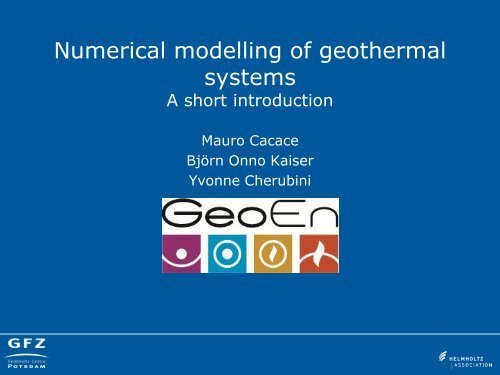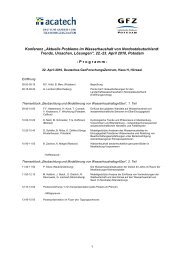Numerical modelling of geothermal systems A short ... - Geo.X
Numerical modelling of geothermal systems A short ... - Geo.X
Numerical modelling of geothermal systems A short ... - Geo.X
You also want an ePaper? Increase the reach of your titles
YUMPU automatically turns print PDFs into web optimized ePapers that Google loves.
<strong>Numerical</strong> <strong>modelling</strong> <strong>of</strong> <strong>geothermal</strong><br />
<strong>systems</strong><br />
A <strong>short</strong> introduction<br />
Mauro Cacace<br />
Björn Onno Kaiser<br />
Yvonne Cherubini
Mathematical model<br />
Description (approximated) <strong>of</strong> a system using mathematical concepts<br />
Mathematical representation<br />
o<br />
o<br />
o<br />
o<br />
Variables<br />
Inputs<br />
Outputs<br />
Internal state<br />
Internal processes<br />
Mathematical equations<br />
Description <strong>of</strong> the<br />
interactions among these<br />
variables<br />
Conceptual model<br />
Analytical model<br />
<strong>Numerical</strong> model<br />
Homogeneous and simple (linear) processes Heterogenous, coupled (non-linear) processes<br />
<strong>Geo</strong>thermal Reservoirs<br />
Modelling
Conceptual model<br />
<strong>Numerical</strong> model<br />
Continuos<br />
PDEs<br />
∆f x, y, z = 0<br />
Discretization<br />
Linear Algebraic<br />
Systems<br />
A ij ∙ f i = 0<br />
<strong>Geo</strong>thermal Reservoirs<br />
Modelling
Finite Differences vs Finite Element<br />
o Linear approximations<br />
o Regular or pseudo-irregular<br />
supprting meshes (grids)<br />
o Simple geometries<br />
o Low computational efforts<br />
o Polynomial approximations<br />
(Weak solution)<br />
o Fully irregular supporting<br />
meshes<br />
o Complex geometries<br />
o High Computational efforts<br />
<strong>Geo</strong>thermal Reservoirs<br />
Modelling
Regionally localized geological setting where heat flow from the Earth‘s interior is<br />
transported close enough to the surface by circulating steam or hot water to be readily<br />
harnesed for use<br />
Heat<br />
Water<br />
Energy<br />
Working Fluid<br />
© 2000 <strong>Geo</strong>thermal Education Office<br />
Requirements<br />
Reservoir Permeable and porous rock bounded by impermeable formations<br />
<strong>Geo</strong>thermal Reservoirs<br />
Introduction
Reservoir <strong>systems</strong><br />
Engineering perspective<br />
Courtesy <strong>of</strong> Guido Blöcher GFZ Potsdam<br />
<strong>Geo</strong>thermal Reservoirs<br />
Introduction
Reservoir <strong>systems</strong><br />
Engineering perspective<br />
<strong>Geo</strong>thermal reservoir is …<br />
Heat<br />
and<br />
! PERMEABILITY, PERMEABILITY, PERMEABILITY !<br />
<strong>Geo</strong>thermal Reservoirs<br />
Introduction
Multiphysics <strong>systems</strong><br />
Reservoir <strong>systems</strong><br />
Modelling perspective<br />
Coupled Processes<br />
H<br />
T<br />
M<br />
C<br />
Hydraulic processes<br />
Fluid and two phase flow, heat and<br />
mass transport, fluid pressure changes<br />
Thermal<br />
Conductive and convective heat flux,<br />
internal heat production<br />
Mechanical<br />
Rock deformation, fracture initiation and<br />
propagation, thermo and poroelastic<br />
effects<br />
Chemical<br />
Chemical reactions, corrosion and<br />
scaling<br />
<strong>Geo</strong>thermal Reservoirs<br />
Introduction
H T M<br />
Processes<br />
Fluid or Two Phase<br />
Flow<br />
Permeability<br />
Heat flow<br />
Fracture & Fault<br />
Mechanics<br />
Poroelastics<br />
C<br />
Thermoelastics<br />
Chemical Reactions<br />
Corrosion & Scaling<br />
Natural<br />
Engineered<br />
Reservoir<br />
Components<br />
<strong>Geo</strong>logy<br />
Fault Systems<br />
Natural Fractures<br />
Completed wells<br />
Induced Fractures<br />
<strong>Geo</strong>thermal fluid<br />
loop<br />
Enhanced<br />
<strong>Geo</strong>thermal<br />
System<br />
Courtesy <strong>of</strong> Guido Blöcher GFZ Potsdam<br />
<strong>Geo</strong>thermal Reservoirs<br />
Introduction
H T M<br />
Processes<br />
Fluid or Two Phase<br />
Flow<br />
Permeability<br />
Heat flow<br />
Fracture & Fault<br />
Mechanics<br />
Poroelastics<br />
C<br />
Thermoelastics<br />
Chemical Reactions<br />
Corrosion & Scaling<br />
Natural<br />
Engineered<br />
Reservoir<br />
Components<br />
<strong>Geo</strong>logy<br />
Fault Systems<br />
Natural Fractures<br />
Completed wells<br />
Induced Fractures<br />
<strong>Geo</strong>thermal fluid<br />
loop<br />
Enhanced<br />
<strong>Geo</strong>thermal<br />
System<br />
Courtesy <strong>of</strong> Guido Blöcher GFZ Potsdam<br />
<strong>Geo</strong>thermal Reservoirs<br />
Introduction
Groß Schönebeck at a glance<br />
Hamburg<br />
Groß<br />
Schönebeck<br />
o<br />
Location<br />
approx. 40 km north <strong>of</strong> Berlin<br />
Hannover<br />
Berlin<br />
o<br />
Doublet system<br />
January 2007<br />
Köln<br />
o<br />
o<br />
o<br />
o<br />
Low-enthalpy Reservoir<br />
-3850 m to -4260 m<br />
Reservoir rocks Lower Permian<br />
Siliclastics and Volcanics<br />
Natural major fault zones<br />
NW-, and NNE-striking<br />
Hydraulically Induced fractures<br />
3 stimulation treatments<br />
Moeck et al. (2009)<br />
Groß Schönebeck <strong>Geo</strong>thermal Facility
Groß Schönebeck <strong>Geo</strong>thermal Facility
H T M<br />
Processes<br />
Fluid or Two Phase<br />
Flow<br />
Permeability<br />
Heat flow<br />
Fracture & Fault<br />
Mechanics<br />
Poroelastics<br />
C<br />
Thermoelastics<br />
Chemical Reactions<br />
Corrosion & Scaling<br />
Natural<br />
Engineered<br />
Reservoir<br />
Components<br />
<strong>Geo</strong>logy<br />
Fault Systems<br />
Natural Fractures<br />
Completed wells<br />
Induced Fractures<br />
<strong>Geo</strong>thermal fluid<br />
loop<br />
Enhanced<br />
<strong>Geo</strong>thermal<br />
System<br />
Courtesy <strong>of</strong> Guido Blöcher GFZ Potsdam<br />
<strong>Geo</strong>thermal Reservoirs Modelling<br />
Components
• <strong>Geo</strong>logical Units <br />
<strong>Geo</strong>thermal Reservoirs Modelling<br />
Components
• <strong>Geo</strong>logical Units <br />
• Induced Fractures / Natural fault Systems <br />
<strong>Geo</strong>thermal Reservoirs Modelling<br />
Components
• <strong>Geo</strong>logical Units <br />
• Induced Fractures / Natural fault Systems <br />
• Injection & Production Well <br />
<strong>Geo</strong>thermal Reservoirs Modelling<br />
Components
H T M<br />
Processes<br />
Fluid or Two Phase<br />
Flow<br />
Permeability<br />
Heat flow<br />
Fracture & Fault<br />
Mechanics<br />
Poroelastics<br />
C<br />
Thermoelastics<br />
Chemical Reactions<br />
Corrosion & Scaling<br />
Natural<br />
Engineered<br />
Reservoir<br />
Components<br />
<strong>Geo</strong>logy<br />
Fault Systems<br />
Natural Fractures<br />
Completed wells<br />
Induced Fractures<br />
<strong>Geo</strong>thermal fluid<br />
loop<br />
Enhanced<br />
<strong>Geo</strong>thermal<br />
System<br />
Courtesy <strong>of</strong> Guido Blöcher GFZ Potsdam<br />
<strong>Geo</strong>thermal Reservoirs Modelling<br />
Processes
Fluid flow<br />
H T M<br />
C<br />
Darcy‘s<br />
Law<br />
v f = − k μ ∇ (p + ρgze z)<br />
v f = Darcy velocity m ∙ s −1<br />
k = permeability [m 2 ]<br />
μ = dynamic viscosity [Pa ∙ s]<br />
p = pressure [Pa]<br />
ρ = fluid density [kg ∙ m −3 ]<br />
g = acceleration coefficient [m ∙ s −2 ]<br />
z = reference height [m]<br />
<strong>Geo</strong>thermal Reservoirs Modelling<br />
Processes
Fluid flow<br />
H T M<br />
C<br />
Piezometric head [h]<br />
h ≝ z + p<br />
ρg<br />
Hydraulic conductivity [K]<br />
K ≝ (ρg) k μ<br />
v f = −K ∇ ∙ h = −K grad(h)<br />
<strong>Geo</strong>thermal Reservoirs Modelling<br />
Processes
Permeability – porous medium<br />
H T M<br />
C<br />
o Permeability in an intrinsic property <strong>of</strong> the porous medium<br />
o Measure the easiness <strong>of</strong> flow<br />
o Magnitude is controlled by the grain size (pore size)<br />
Hornberger et al. (1998)<br />
<strong>Geo</strong>thermal Reservoirs<br />
Introduction
Permeability – fractures<br />
H T M<br />
Formulas are analytical solutions and valid for laminar (Hagen Poiseuille or<br />
Couette) flow between two ideal plates without roughness<br />
C<br />
Fracture permeability<br />
Fracture conductivity<br />
k = a2<br />
12<br />
K = a2 ∙ ρ ∙ g<br />
12 ∙ μ<br />
<strong>Geo</strong>thermal Reservoirs<br />
Introduction
Fluid flow<br />
H T M<br />
C<br />
Balance equation<br />
S ∂h<br />
∂t = −∇ ρK∇h + Q = −∇ ρv f<br />
+ Q<br />
<strong>Geo</strong>thermal Reservoirs Modelling<br />
Processes
Fluid flow<br />
H T M<br />
C<br />
Balance equation<br />
S ∂h<br />
∂t = −∇ ρK∇h + Q = −∇ ρv f<br />
+ Q<br />
Specific Storativity<br />
Mass source term<br />
S = γ α + φ ∙ β<br />
γ = ρg = Specific weight <strong>of</strong> water [Nm −3 ]<br />
φ = Effective porosity [−]<br />
α = Bulk compressibility [m 2 N −1 ]<br />
β = Fluid compressibility [m 2 N −1 ]<br />
Darcy velocity<br />
v f = −K ∇ ∙ h<br />
<strong>Geo</strong>thermal Reservoirs Modelling<br />
Processes
Heat flow<br />
Conductive and convective<br />
H T M<br />
C<br />
[φ ρc p f<br />
+(1 − φ) ρc p S<br />
] ∂T<br />
∂t + ρc p f<br />
∇ ∙ v f T − ∇ ∙ φλ f + 1 − φ λ S ∇T = H Sf<br />
<strong>Geo</strong>thermal Reservoirs Modelling<br />
Processes
Heat flow<br />
Conductive and convective<br />
H T M<br />
C<br />
[φ ρc p f<br />
+(1 − φ) ρc p S<br />
] ∂T<br />
∂t + ρc p f<br />
∇ ∙ v f T − ∇ ∙ φλ f + 1 − φ λ S ∇T = H Sf<br />
Fourier‘s Law<br />
q = −λ ∙ ∇T<br />
q = heat flow density [W ∙ m −2 ]<br />
λ = heat conductivity W ∙ (m ∙ K) −1<br />
∇T = thermal gradient [K ∙ m −1 ]<br />
<strong>Geo</strong>thermal Reservoirs Modelling<br />
Processes
Heat flow<br />
Conductive and convective<br />
H T M<br />
C<br />
[φ ρc p f<br />
+(1 − φ) ρc p S<br />
] ∂T<br />
∂t + ρc p f<br />
∇ ∙ v f T − ∇ ∙ φλ f + 1 − φ λ S ∇T = H Sf<br />
Darcy‘s Law<br />
v f = −K ∇ ∙ h<br />
<strong>Geo</strong>thermal Reservoirs Modelling<br />
Processes
Fluid and Heat flow<br />
H T M<br />
C<br />
S ∂h<br />
∂t = −∇ ρv f<br />
+ Q<br />
[φ ρc p f<br />
+(1 − φ) ρc p S<br />
] ∂T<br />
∂t + ρc p f<br />
∇ ∙ v f T − ∇ ∙ φλ f + 1 − φ λ S ∇T = H Sf<br />
<strong>Geo</strong>thermal Reservoirs Modelling<br />
Processes
Fluid and Heat flow<br />
H T M<br />
C<br />
S ∂h<br />
∂t = −∇ ρv f<br />
+ Q<br />
v f = −K ∇ ∙ h<br />
[φ ρc p f<br />
+(1 − φ) ρc p S<br />
] ∂T<br />
∂t + ρc p f<br />
∇ ∙ v f T − ∇ ∙ φλ f + 1 − φ λ S ∇T = H Sf<br />
<strong>Geo</strong>thermal Reservoirs Modelling<br />
Processes
Boundary conditions<br />
1 st type (Dirichlet):<br />
• pressure (head), temperature,<br />
concentration<br />
2 nd type (Neumann):<br />
• flux<br />
3 rd type (Cauchy):<br />
• transfer<br />
4 th type (FeFlow):<br />
• well
Results – Step 1<br />
Natural flow field
Results – Step 2<br />
Doublet System (hydraulic)
Results – Step 3<br />
Doublet System (hydro-thermal)
Results – Step 4<br />
Doublet System with induced fractures





